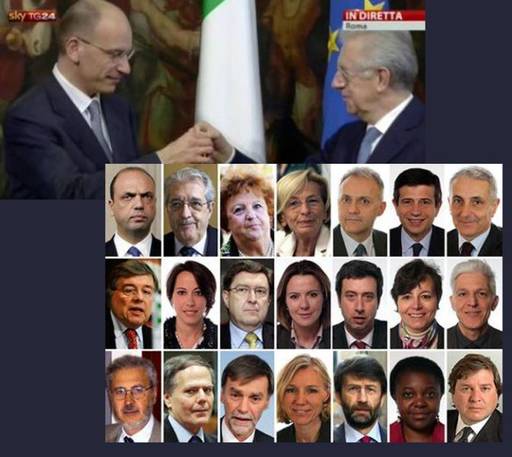ROME - Aboard the omnibus cabinet assembled this weekend by the youthful and canny Premier-designate Enrico Letta, under the watchful eye of President Giorgio Napolitano, are 21 cabinet ministers. Letta's government is expected to take office early this week with support from Silvio Berlusconi's Freedom Party (PdL), Mario Monti's smaller centrist party Movimento Civico and Letta's own Partito Democratico (PD).Most are fresh faces, and the new look is cause for optimism. Despite a smattering of old pols, there are young politicians as well as a few experts, if not always in the fields they are destined to govern. Above all, there are the politically correct, who include more women than any Italian cabinet has ever before fielded. Among these is one African-born black woman, whose presence immediately triggered veiled racist protests from the Northern League that the forthcoming government would be soft on illegal immigration.
The congenial Letta, 46, continues to apply the term "sober" at every opportunity to describe his governing aims. In effect his life itself is fairly sober although he lives in the colorful downtown Roman neighborhood of Testaccio and rides around town on a Vespa. He trained in political science at the University of Pisa and was later associated with the respected Nino Andreatta, at one time economic counsellor to Aldo Moro. Letta has served twice in government, once as Minister for EU policies and then as Minister for Industry. He is the nephew of Gianni Letta, senior counsellor to Silvio Berlusconi, and, when uncle Letta participated in pre-government talks together with Berlusconi, many read this as more of the usual Italian familism, with Letta Senior a guarantor protecting Berlusconi's interests. On the other hand, Gianni Letta was in fact Berlusconi's ambassador to the Vatican or, put more correctly, he was the Vatican's ambassador to Berlusconi. And indeed that Vatican connection may be more important in hatching the new government than any link with Berlusconi, who personally aimed to be given the economics ministry, or for it to go to his faithful economist ally Renato Brunetta. Enrico Letta kept both Berlusconi and Brunetta at bay.
But the general sense is of admiration for Letta's creativity. The most prestigious is perhaps Emma Bonino, former EU Commissioner, who will be his foreign affairs minister. The average age of the ministers is, at 54, youthful for Italy. In addition, Letta managed to dodge inclusion of a number of all too familiar faces. Among the missing: Renato Brunetta and Silvio Berlusconi of the Liberty party (PdL) on the right, Massimo D'Alema of the Partito Democratico (PD) on the left. Reportedly it was Mario Monti's withdrawing of his name for consideration that also axed D'Alema's possibility for a return as foreign minister.
True, Letta was obliged to make Angelino Alfano, the Sicilian politician who was Berlusconi's assistant for years before becoming deputy head of the PdL, both deputy premier and interior minister. At the same time Letta succeeded in naming Anna Maria Cancellieri minister of justice. This essentially pits Alfano against his feisty and seasoned female predecessor at the Interior Ministry, Cancellieri, His job is preside over the police investigations into possible Mafia collusion with the powers-that-be; hers is to oversee those judicial processes which affect a large number of politicians of every stripe, including Berlusconi himself.
How long will it last? No one expects this legislature to withstand a five-year term. But it should last long enough for Letta to demonstrate to those in his own PD who voted for Grillo that ordinary, normal politics can function. If so, he will have driven a stake into Grillo power - but only after a new and fairer election law is passed.


